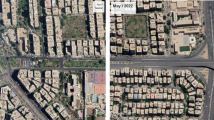Abstract
We estimated wet-bulb globe temperature (WBGT) using measured meteorological data to understand the bioclimates of human living spaces during the summer season. Our research focused on commercial and residential areas of Okayama City, Japan (population ∼700,000). The commercial spaces (CO) mainly consisted of multi-story office buildings, whereas the residential spaces (RE) consisted of one- or two-story residential buildings. On a fine day with southeast winds, the spatially averaged WBGT measured in the CO was higher than that in the RE. The difference was statistically significant and would have caused noticeable discomfort and a high risk of heat disorder for occupants of the CO over the long term. For instance, at 1900 Japan Standard Time (JST), the maximum difference in the WBGT between the CO and RE sites was 2.0°C (23.5°C for the CO and 21.5°C for the RE). From 1800 to 1900 JST, the wet-bulb temperature in the CO was still 1.5–2.0°C higher than that in the RE, even though both areas had the same dry-bulb temperature. This indicates that the CO retained greater amounts of water vapor for longer periods compared to the RE. The wet-bulb temperature in the CO increased rapidly at most observation points when the southeast sea breeze arrived. In contrast, in the RE, the wet-bulb temperature decreased until evening. This difference was caused by moist air transported from a river about 1 km upwind from the CO. The moist air forced an increase in the WBGT and elevated the risk of heat disorder in the CO. The spatially averaged globe temperature of the CO at 1500 JST was 6.2°C lower than that at the RE, causing the WBGT of the CO to decrease. The results suggest that the higher WBGT in the CO was caused by higher wet-bulb temperatures. On a day with southwest winds, the CO and RE showed no difference in WBGT because the river was not included in the upwind source area.







Similar content being viewed by others
References
Barradas VL (1991) Air temperature and humidity and human comfort index of some city parks of Mexico City. Int J Biometeorol 35:24–28
de la Casa AC, Ravelo AC (2003) Assessing temperature and humidity conditions for dairy cattle in Cordoba, Argentina. Int J Biometeorol 48:6–9
Hoshi A, Inaba Y (2005) Meteorological conditions and sports deaths at school in Japan, 1993–1998. Int J Biometeorol 49:224–231
Hughson RL, Staudt LA, Mackie JM (1983) Monitoring road racing in the heat. Phys Sportsmed 11:94–105
Japan Meteorological Agency (1999) Taiyoukou Hatsuden Shisutemu Jitsuyouka Gizyutsu Kaihatsu. New Energy and Industrial Technology Development Organization (NEDO) report (in Japanese)
Kondo H, Genchi Y, Kikegawa Y, Ohashi Y, Yoshikado H, Komiyama H (2005) Development of multi-layer urban canopy model for the analysis of energy consumption in a big city: structure of the urban canopy model and its basic performance. Boundary-Layer Meteorol 116:395–421
Kusaka H, Kondo H, Kikegawa Y, Kimura F (2001) A simple single-layer urban canopy model for atmospheric models: comparison with multi-layer and slab models. Boundary-Layer Meteorol 101:329–358
Nimiya H, Akasaka H, Matsuno Y, Soga K (1997) A method to estimate the hourly solar radiation using AMeDAS data. Part 2: Application to the improved sunshine recorder of AMeDAS (in Japanese). J Soc Heat Air-Cond Sanitar Eng Jpn 65:53–65
Ohashi Y, Genchi Y, Kikegawa Y, Kondo H, Yoshikado H, Hirano Y (2007) Influence of air-conditioning waste heat on air temperature in Tokyo office areas during summer: numerical experiments using an Urban Canopy Model coupled with a building energy model. J Appl Meteorol Climatol 46:66–81
Pasquill F (1961) The estimation of the dispersion of windborn material. Meteorol Mag 90:33–49
Saaroni H, Ziv B (2003) The impact of a small lake on heat stress in a Mediterranean urban park: the case of Tel Aviv, Israel. Int J Biometeorol 47:156–165
Schmid HP (1994) Source areas for scalars and scalar fluxes. Boundary-Layer Meteorol 67:293–318
Smolander J, Ilmarinen R, Korhonen O (1991) An evaluation of heat stress indices (ISO 7243, ISO/DIS 7933) in the prediction of heat strain in unacclimated men. Int Arch Occup Environ Health 63:39–41
Somparn P, Gibb MJ, Markvichitr K, Chaiyabutr N, Thummabood S, Vajrabukka C (2004) Analysis of climatic risk for cattle and buffalo production in northeast Thailand. Int J Biometeorol 49:59–64
Tonouchi M, Murayama K, Ono M (2006) WBGT forecast for prevention of heat stroke in Japan. Sixth Symposium on the Urban Environment, American Meteorological Society, session PJ1.1
Yaglou CP, Minard CD (1957) Control of casualties at military training centers. A.M.A Archives of Industrial Health 16:304–314
Acknowledgements
The meteorological data were provided by the Japan Meteorological Agency, Okayama Prefecture, and relevant cities.
Author information
Authors and Affiliations
Corresponding author
Rights and permissions
About this article
Cite this article
Ohashi, Y., Kawabe, T., Shigeta, Y. et al. Evaluation of urban thermal environments in commercial and residential spaces in Okayama City, Japan, using the wet-bulb globe temperature index. Theor Appl Climatol 95, 279–289 (2009). https://doi.org/10.1007/s00704-008-0006-8
Received:
Accepted:
Published:
Issue Date:
DOI: https://doi.org/10.1007/s00704-008-0006-8




